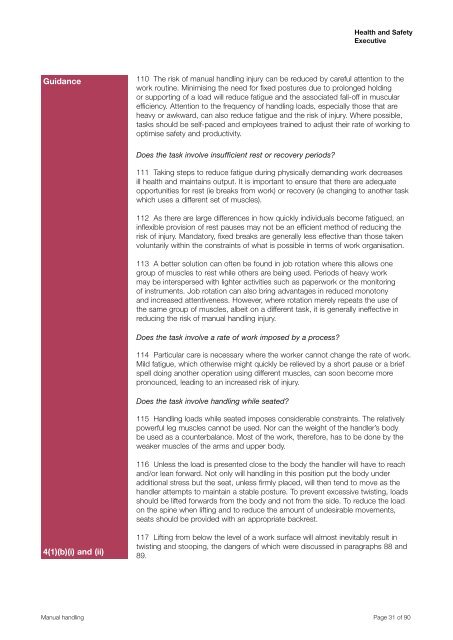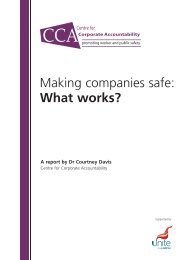Manual Handling Manual Handling Operations Regulations 1992 ...
Manual Handling Manual Handling Operations Regulations 1992 ...
Manual Handling Manual Handling Operations Regulations 1992 ...
Create successful ePaper yourself
Turn your PDF publications into a flip-book with our unique Google optimized e-Paper software.
Health and Safety<br />
Executive<br />
Guidance<br />
110 The risk of manual handling injury can be reduced by careful attention to the<br />
work routine. Minimising the need for fixed postures due to prolonged holding<br />
or supporting of a load will reduce fatigue and the associated fall-off in muscular<br />
efficiency. Attention to the frequency of handling loads, especially those that are<br />
heavy or awkward, can also reduce fatigue and the risk of injury. Where possible,<br />
tasks should be self-paced and employees trained to adjust their rate of working to<br />
optimise safety and productivity.<br />
Does the task involve insufficient rest or recovery periods?<br />
111 Taking steps to reduce fatigue during physically demanding work decreases<br />
ill health and maintains output. It is important to ensure that there are adequate<br />
opportunities for rest (ie breaks from work) or recovery (ie changing to another task<br />
which uses a different set of muscles).<br />
112 As there are large differences in how quickly individuals become fatigued, an<br />
inflexible provision of rest pauses may not be an efficient method of reducing the<br />
risk of injury. Mandatory, fixed breaks are generally less effective than those taken<br />
voluntarily within the constraints of what is possible in terms of work organisation.<br />
113 A better solution can often be found in job rotation where this allows one<br />
group of muscles to rest while others are being used. Periods of heavy work<br />
may be interspersed with lighter activities such as paperwork or the monitoring<br />
of instruments. Job rotation can also bring advantages in reduced monotony<br />
and increased attentiveness. However, where rotation merely repeats the use of<br />
the same group of muscles, albeit on a different task, it is generally ineffective in<br />
reducing the risk of manual handling injury.<br />
Does the task involve a rate of work imposed by a process?<br />
114 Particular care is necessary where the worker cannot change the rate of work.<br />
Mild fatigue, which otherwise might quickly be relieved by a short pause or a brief<br />
spell doing another operation using different muscles, can soon become more<br />
pronounced, leading to an increased risk of injury.<br />
Does the task involve handling while seated?<br />
115 <strong>Handling</strong> loads while seated imposes considerable constraints. The relatively<br />
powerful leg muscles cannot be used. Nor can the weight of the handler’s body<br />
be used as a counterbalance. Most of the work, therefore, has to be done by the<br />
weaker muscles of the arms and upper body.<br />
116 Unless the load is presented close to the body the handler will have to reach<br />
and/or lean forward. Not only will handling in this position put the body under<br />
additional stress but the seat, unless firmly placed, will then tend to move as the<br />
handler attempts to maintain a stable posture. To prevent excessive twisting, loads<br />
should be lifted forwards from the body and not from the side. To reduce the load<br />
on the spine when lifting and to reduce the amount of undesirable movements,<br />
seats should be provided with an appropriate backrest.<br />
4(1)(b)(i) and (ii)<br />
117 Lifting from below the level of a work surface will almost inevitably result in<br />
twisting and stooping, the dangers of which were discussed in paragraphs 88 and<br />
89.<br />
<strong>Manual</strong> handling Page 31 of 90
















